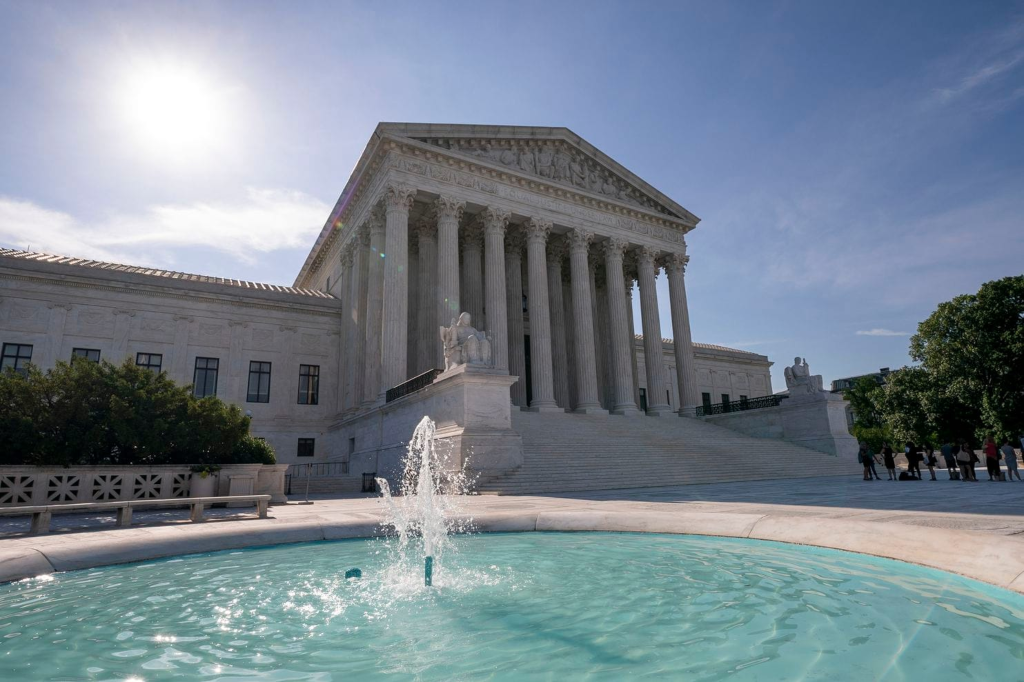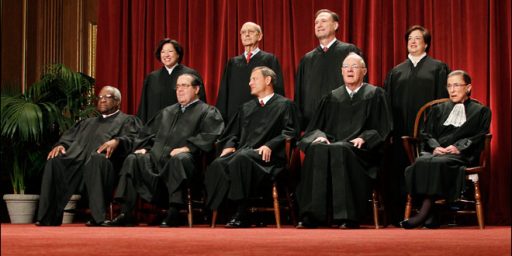Supreme Court Dismisses Virginia Legislature’s Effort To Challenge Racial Gerrymandering Ruling
The Supreme Court rejected an effort by the Virginia House of Delegates to overturn a Federal Court ruling that the state's district lines constituted gerrymandering by race. But they didn't rule on the merits of the appeal.

On Monday, Supreme Court dismissed the appeal of the Virginia House of Delegates challenging the finding of a Federal District Court striking down the Commonwealth’s district lines due to racial gerrymandering, but the case did not reach the merits of the parties’ arguments:
WASHINGTON — The Supreme Court on Monday dismissed a challenge to the voting map for Virginia’s House of Delegates, saying that state lawmakers were not entitled to appeal a ruling striking down parts of the map on race-discrimination grounds. The Supreme Court’s action is likely to help Democrats in elections this fall.
The vote was 5 to 4, and it scrambled some of the court’s usual alliances. Justices Clarence Thomas and Neil M. Gorsuch were in the majority, and Justice Stephen G. Breyer was among the dissenters.
The case, Virginia House of Delegates v. Bethune-Hill, No. 18-281, arose from a squabble among state officials. The state’s attorney general, a Democrat, decided not to appeal the ruling striking down the voting maps. The state’s House of Delegates, controlled by Republicans, filed its own appeal.
Writing for the majority, Justice Ruth Bader Ginsburg said the House was not authorized to pursue the appeal on behalf of the state and had not suffered the sort of direct injury that would give it standing to sue in its own right.
“Virginia, had it so chosen, could have authorized the House to litigate on the state’s behalf, either generally or in a defined class of cases,” she wrote. “But the choice belongs to Virginia, and the House’s argument that it has authority to represent the state’s interests is foreclosed by the state’s contrary decision.”
Justices Sonia Sotomayor and Elena Kagan also joined the majority opinion.
In dissent, Justice Samuel A. Alito Jr. wrote that the House had suffered an injury and therefore could sue. “It is,” he wrote, “precisely because of the connections between the way districts are drawn, the composition of a legislature and the things that a legislature does that so much effort is invested in drawing, contesting and defending districting plans.”
“Does a string quartet have an interest in the identity of its cellist?” he asked. “Does a basketball team have an interest in the identity of its point guard?”
Chief Justice John G. Roberts Jr. and Justice Brett M. Kavanaugh also joined the dissent.
The case concerned 11 voting districts drawn after the 2010 census, each with at least a 55 percent population of black residents of voting age. Democratic voters in those districts sued, saying that lawmakers had run afoul of the Constitution by packing too many black voters into the districts, diminishing their voting power.
[VIrginia Attorney General Mark] Herring said he welcomed the ruling. “This is a big win for democracy in Virginia,” he said in a statement. “It’s unfortunate that House Republicans wasted millions of taxpayer dollars and months of litigation in a futile effort to protect racially gerrymandered districts, but the good news is that this fall’s elections will take place in constitutionally drawn districts.”
Monday’s decision was the Supreme Court’s second ruling in the case. In 2017, the justices instructed a three-judge Federal District Court to take a new look at whether racial consideration had played too large a role in drawing the legislative map for the House of Delegates.
The district court, which had initially upheld the districts, struck them down last year.
Amy Howe offers this analysis at SCOTUSBlog:
Justice Ruth Bader Ginsburg wrote for the majority, in an opinion that was joined by Justices Clarence Thomas, Sonia Sotomayor, Elena Kagan and Neil Gorsuch.
The House of Delegates, Ginsburg explained, argued first that it had standing to appeal to the Supreme Court to represent Virginia’s interests. But Virginia law makes clear, Ginsburg emphasized, that only the state’s attorney general has the authority to represent the state in civil litigation.
Indeed, Ginsburg noted, even if Virginia had given the House of Delegates the power to represent the state, the House of Delegates never indicated in the lower court that it was doing so; instead, “the House has purported to represent its own interests” throughout the case.
Ginsburg also rejected the House’s argument that it has standing to appeal in its own right. Addressing the House’s contention that it is “the legislative body that actually drew the redistricting plan” and would lose power to draw the new districts if a remedial order gave that power to the district court, Ginsburg observed that state law gives power over redistricting to the state’s General Assembly, “of which the House constitutes only a part.” This case is therefore different, Ginsburg reasoned, from a 2015 case in which the Supreme Court agreed that both houses of Arizona’s legislature could challenge the constitutionality of a referendum that gave authority over redistricting to an independent commission. Moreover, Ginsburg added, in the Arizona case the referendum permanently deprived the legislature of its role in redistricting, while in this case the remedial order “does not alter the General Assembly’s dominant initiating and ongoing role in redistricting.”
Ginsburg similarly dismissed the House’s argument that it had standing to appeal the district court’s order because the new maps would affect its membership: Even if that were true, she concluded, “the House as an institution has no cognizable interest in the identity of its members,” and changes to those members, therefore, would not provide the kind of harm that the House would need to have standing.
Justice Samuel Alito dissented, in an opinion that was joined by Chief Justice John Roberts and Justices Stephen Breyer and Brett Kavanaugh. Alito would have held that the House did have standing because the use of the new court-ordered map would “harm the House in a very fundamental way.” In particular, Alito explained, “it is precisely because of the connections between the way districts are drawn, the composition of a legislature, and the things that a legislature does that so much effort is invested in drawing, contesting, and defending districting plans.” “To suggest otherwise, to argue that substituting one plan for another has no effect on the work or output of the legislative body whose districts are changed,” Alito posited, “would really be quite astounding.”
What all of this basically means is that the Court ruled that the House of Delegates did not have legal standing to pursue the appeal once the Commonwealth, acting through the Governor and Attorney General, had decided against appealing the ruling of the three-judge panel in the District Court. This means in the immediate term that the state legislature will be operating, and will conduct its 2019 midterm elections based on, the map that was drawn by the court-appointed Speical Master in the case below and that this map will remain in effect until the next round of redistricting in 2022.
While the Supreme Court’s action here does dodge the gerrymandering issue, it also raises some interesting questions about standing that could have an implication on other cases, including several that have been filed against Trump Administration policies. Specifically, the majority opinion puts emphasis on the fact that the appeal was being pursued by only one chamber of Virginia’s bicameral state legislature. It’s unclear whether the outcome of the standing issue would have been different if the State Senate had chosen to join in the lawsuit, but that fact could potentially impact several cases pending against the President that has been brought by only one chamber of Congress. These include claims that the President has violated the Emoluments Clauses of the Constitution and a challenge to his assertion of a “national emergency” at the southern border as a means to get funds to build part of his border wall. It’s unclear whether this ruling would also apply to the question of whether the House of Representatives has legal standing to sue the President on its own.
That, however, will have to be an issue for another day. As things stand, the District Court’s finding below that there was racial gerrymandering in the drawing of Virginia’s districts after the 2010 Census stands as good law.
Here’s the opinion:
Virginia House of Delegates… by on Scribd






Why hasn’t Ray Guy been appointed to the Supreme Court?
What a strange world view, to feel that forcing the House to be elected by districts that were NOT racially gerrymandered constitutes harm to the House…
@DrDaveT:
That’s putting the cart before the horse.
The question is whether the change in district lines, whether the District Court was justified in reaching the conclusion it did or not, is sufficient to give the House of Delegates legal standing. The Suprme Court did not rule on the legal merits of the decision below because it found that the HoD did not have standing.
The whole string of gerrymandering (racial and otherwise) decisions the last few years make it perfectly clear that the Supreme Court really really REALLY doesn’t want to deal with the issue. The loopholes they find and create to avoid saying “drawing districts for partisan advantage is fundamentally undemocratic and thus unconstitutional, so would you a-holes play fair with each other” is ludicrous. They’re practically begging someone-anyone-to make the issue go away. Apparently because they can’t comprehend that our political parties have never played fair on the issue of gerrymandering and that modern technology has changed things from a quirk that sometimes backfired into a lethal method of disenfranchisement.
I know it’s way too popular to say an issue requires a Constitutional amendment to resolve, but in this case I don’t see another way forward. How power is elected is fundamental, and the only institution that can deal with gerrymandering is consistently burying it’s head in the ground because they can’t find a consistent legal principle and are incapable (apparently) of understanding the math that exists to indicate when a district has been drawn for partisan advantage.
@Just Another Ex-Republican: Gerrymandering has been around since the dawn of our pseudo-Democratic Republic, we’re just way better at it now.
It’s sort of like how you never had a right to privacy out on the city streets, but now there are cameras everywhere, so the state’s ability to keep tabs on everyone has dramatically increased.
I don’t think the Court has figured out what to do there either.
There are some things that the Founding Fathers didn’t consider, because they weren’t able to consider it, and attempts to find the right answer in the text of their writings is doomed to fail. It would be more appropriate to issue a ruling that says “yo, the constitution doesn’t address this” rather than attempting to either apply the text to cases it wasn’t meant for, or try to decide what Madison would have thought about private individuals having weapons of mass destruction.
It’s not that far from “English common law forbade witchcraft, and these wireless communication devices would have been considered witchcraft, so we hold that there is no expectation of privacy while committing witchcraft.”
@Doug Mataconis:
That was the majority opinion, yes. But that is not what the quote from Alito says, writing in dissent. Either he was badly misquoted (which is possible), or he actually said in his dissent that the HoD should be granted standing because having to use the de-gerrymandered map would constitute harm to them.
@Kathy:
Fist bump for the Ray Guy reference…
@Daryl and his brother Darryl:
Thanks!
@DrDaveT:
I think you are attributing to the Court’s use of the word “harm” a less legalistic definition. This use of “harm” means only that their authority or lack of authority to gerrymander (or set boundaries) will impact them in a way that should give them a say about the impact.
I am not personally very sorry for the impact a less-gerrymandered map will have, but I don’t think the Supreme Court is really attributing a value to the change in mapping.
@Joe:
I understand that ‘harm’ is a term of art, but it’s still nuts. You could equally argue that my authority or lack of authority to steal money from my employees would affect me in a material way, and therefore I should have a say in whether I get to do that or not… Being prevented from stealing from my employees is not ‘harm’ to me, not even in the technical sense.